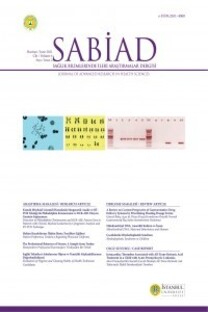INVESTIGATION OF THE EXPRESSION LEVEL OF miR 142-3P IN OVARIAN CARCINOMA
Objective: The most common cancers in women are breast, thyroid, colorectal, uterine corpus, lung and ovarian cancer. Ovarian cancer causes more than 150,000 deaths annually worldwide. The fact that this cancer manifests itself in the late stage and is a disease characterized by poor prognosis causes the vast majority of cases to result in death.The target of diagnosis and treatment of ovarian cancer is to reduce the number of deaths and to increase the quality of life.miRNAs play a role in the pathology of many diseases, including cancer. Materials and Methods: In the preliminary study on miRNA in our group, 99 candidate miRNAs were found to be used in the diagnosis and followup of ovarian cancer. In the presented thesis study, the expression level of miR-142-3p among these miRNAs was examined comparatively with a larger ovarian cancer patient group and control group. In the study, which includes 147 patients and 100 healthy control groups, the expression level of miR-142-3p was determined using the RealTime PCR method. Differences between the expression levels of miR-142-3p detected in peripheral blood lymphocytes of ovarian cancer patients and healthy controls were statistically evaluated. Result: It was found that miR-142-3p expression level increased more than 3 times in ovarian cancer patients compared to healthy controls, and this difference was found to be statistically significant (p = 0.00). Conclusion: As a result suggest that miR-142-3p may be a sensitive, non-invasive biomarker in the early diagnosis of ovarian cancer, but further research is needed to investigate and evaluate the related molecule in ovarian benign diseases.
INVESTIGATION OF THE EXPRESSION LEVEL OF miR 142-3P IN OVARIAN CARCINOMA
Objective: The most common cancers in women are breast, thyroid, colorectal, uterine corpus, lung and ovarian cancer. Ovarian cancer causes more than 150,000 deaths annually worldwide. The fact that this cancer manifests itself in the late stage and is a disease characterized by poor prognosis causes the vast majority of cases to result in death.The target of diagnosis and treatment of ovarian cancer is to reduce the number of deaths and to increase the quality of life.miRNAs play a role in the pathology of many diseases, including cancer. Materials and Methods: In the preliminary study on miRNA in our group, 99 candidate miRNAs were found to be used in the diagnosis and followup of ovarian cancer. In the presented thesis study, the expression level of miR-142-3p among these miRNAs was examined comparatively with a larger ovarian cancer patient group and control group. In the study, which includes 147 patients and 100 healthy control groups, the expression level of miR-142-3p was determined using the RealTime PCR method. Differences between the expression levels of miR-142-3p detected in peripheral blood lymphocytes of ovarian cancer patients and healthy controls were statistically evaluated. Result: It was found that miR-142-3p expression level increased more than 3 times in ovarian cancer patients compared to healthy controls, and this difference was found to be statistically significant (p = 0.00). Conclusion: As a result suggest that miR-142-3p may be a sensitive, non-invasive biomarker in the early diagnosis of ovarian cancer, but further research is needed to investigate and evaluate the related molecule in ovarian benign diseases.
___
- Grozescu T, Popa F. Prostate cancer between prognosis and adequate/proper therapy. J Med Life. 2017;10(1):5-12
